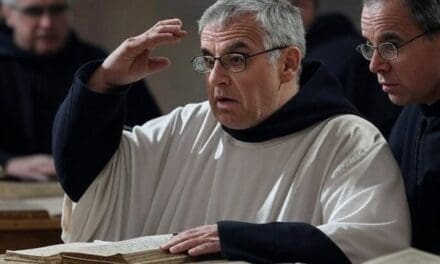Let’s talk about the Biblical account of Enoch, the Joseph Smith accounts of Enoch, and all the resources possibly available to Joseph in 1830, and those not available until long after his death.
The Book of Moses, part of the Pearl of Great Price, was produced by Joseph Smith between June 1830 and February 1831 as part of his “Inspired Translation” of the Bible. Chapters 6 and 7 focus heavily on the figure of Enoch, expanding far beyond the brief mentions in Genesis 5:21-24 and Hebrews 11:5. Smith’s account includes detailed narratives about Enoch’s prophetic calling, his visions, his leadership of a righteous city (Zion), and its eventual translation into heaven. This is a stark contrast to the sparse biblical record, raising the question: where did this material come from?
Critics often argue that Smith must have drawn from sources available in his 19th-century environment. The most prominent candidate is 1 Enoch (also called the Ethiopic Book of Enoch), translated into English by Richard Laurence in 1821. However, the similarities between 1 Enoch and the Book of Moses are minimal compared to those with texts like 2 Enoch, 3 Enoch, and the Book of Giants, which were not available in English(or at all) until after Smith’s death.
Enoch’s Prophetic Call and Self-Doubt
Book of Moses (Moses 6:31-32): Enoch protests his calling, saying, “Why is it that I have found favor in thy sight, and am but a lad, and all the people hate me; for I am slow of speech; wherefore am I thy servant?” God reassures him, promising to fill his mouth with words.
2 Enoch (Ch. 1): Enoch describes himself as unworthy and fearful when approached by divine beings, a motif of reluctance similar to Moses 6.
Book of Giants (Dead Sea Scrolls Fragments): While fragmentary, Enoch is depicted as a figure of authority whom others approach for divine insight, implying a prophetic role consistent with Smith’s portrayal.
Visions of Preexistence and All Humanity
Book of Moses (Moses 6:36, 7:21-67): Enoch sees “all the inhabitants of the earth” and visions spanning from the pre-mortal existence to the end of time, including the weeping of the heavens over human wickedness (Moses 7:28-41).
1 Enoch (Ch. 1-36): Contains some visions of judgment and the cosmos, but lacks the preexistence theme.
2 Enoch (Ch. 7-8): Describes Enoch’s ascent to heaven and visions of the pre-mortal spirits, closely mirroring Moses 7’s scope.
Book of Giants: Mentions Enoch interpreting dreams and visions for the giants, suggesting a broad revelatory capacity, though less detailed than Moses.
The Name Mahijah/Mahujah
Book of Moses (Moses 6:40, 7:2): A figure named Mahijah questions Enoch, and Mahujah is referenced as a place or person Enoch encounters.
Book of Giants (4Q530): A character named Mahaway (or Mahawai, MHWY in Aramaic) interacts with Enoch, asking him to interpret dreams. Scholars like Hugh Nibley and Jeffrey Bradshaw note the linguistic similarity between Mahijah/Mahujah and Mahaway, especially since both figures play a role as questioners or emissaries to Enoch. This name doesn’t appear in 1 Enoch or the Bible (beyond a variant in Genesis 4:18, Mehujael, which lacks the context).
The Righteous City and Translation
Book of Moses (Moses 7:19-21): Enoch’s people become so righteous that their city, Zion, is taken up to God, a concept of “translation” not found in Genesis.
3 Enoch (Ch. 48): Enoch is transformed into Metatron and associated with a heavenly community, though not a city. The Book of Giants doesn’t mention a city, but the broader Enochic tradition (e.g., 1 Enoch 12-16) hints at Enoch’s separation from the wicked world, aligning with the idea of a distinct righteous group.
The Weeping Heavens and Earth
Book of Moses (Moses 7:28-29, 48): God and the heavens weep over human sin, and the earth mourns its corruption.
Book of Giants (4Q530 Frag. 8): The earth and its creatures cry out in distress, a rare personification echoed in Moses 7.
2 Enoch (Ch. 8): The heavens are depicted as responsive to earthly events, though not explicitly weeping.
Enoch as a Youth
Book of Moses (Moses 6:31): Enoch calls himself “a lad,” despite being 65, suggesting a symbolic youth or humility.
Dead Sea Scrolls (4QEnGiants): A fragment refers to Enoch as a “mere youth,” a striking parallel not found in 1 Enoch.
These similarities are specific and often unique, particularly with the Book of Giants, which wasn’t published in English until J.T. Milik and Matthew Black’s work in 1976—132 years after Smith’s death.
What Could Smith Have Known?
Critics’ main contention is that Smith must have derived his Enoch material from sources available in the 1830s. The only Enoch text in English during Smith’s lifetime was 1 Enoch, published in 1821.
Availability of 1 Enoch:Historians like Richard Bushman argue it’s “scarcely conceivable” Smith had access to Laurence’s translation. Smith lived in rural New York, had limited funds (he couldn’t afford a Bible until after the Book of Mormon translation), and there’s no record of him owning or borrowing this rare, expensive academic text. Even if he did, 1 Enoch focuses on the Watchers (fallen angels), their offspring (the giants), and cosmic judgments—themes largely absent from the Book of Moses, which emphasizes Enoch’s preaching, Zion, and preexistence.
Lack of Similarity with 1 Enoch:Scholars like Jed Woodworth and Jeffrey Bradshaw note that while 1 Enoch shares some broad motifs (e.g., Enoch as a prophet), it lacks the specific details of Moses 6-7, like Mahijah, the weeping earth, or Zion’s translation. The strongest parallels are with 2 Enoch, 3 Enoch, and the Book of Giants, all unavailable in Smith’s day.
Post-1844 Discoveries:The Dead Sea Scrolls (1947 onward) and subsequent translations of 2 Enoch (late 19th century) and 3 Enoch (1928) introduced texts that align more closely with Smith’s narrative. Critics can’t plausibly claim he accessed these, as they were unknown to the Western world until decades or centuries later.
Critics often assert that Smith fabricated the Book of Moses, either through imagination or by borrowing from his environment (e.g., Masonic traditions or biblical commentaries). Here’s how the evidence counters these claims:
Improbability of Access to 1 Enoch:Even if Smith miraculously obtained Laurence’s 1 Enoch, its content doesn’t match the Book of Moses closely enough to explain the parallels with later texts. The Book of Giants—with Mahaway and the crying earth—wasn’t even known to exist in 1830, let alone translated.
Specificity of Parallels:The Mahijah/Mahaway connection is particularly compelling. This name, tied to a specific role (questioning Enoch), appears in a Dead Sea Scrolls text discovered in 1948. Critics might argue it’s a coincidence, but the rarity of the name and its contextual fit make this unlikely. Genesis 4:18’s “Mehujael” is a distant linguistic cousin, but lacks the narrative role found in both Moses and the Book of Giants.
Complexity Beyond Imagination:The Book of Moses weaves a coherent narrative with details—like the preexistence, Zion’s translation, and the weeping heavens—that align with ancient Enochic traditions but were not part of 19th-century Christian thought. Smith, with minimal education and no apparent access to scholarly resources, producing such a text by chance strains credulity.
Timing of Discoveries:The Book of Giants and other Qumran texts surfaced over a century after Smith’s death. Critics can’t retroactively attribute these to his sources without invoking time travel or an implausible secret library. Hugh Nibley famously called the Book of Moses a “foolproof test” of Smith’s inspiration, precisely because it can be measured against ancient records unknown in his time.
Alternative Explanations Fall Short:Masonic influence (suggested by some) includes Enoch legends, but these focus on pillars or treasure, not Zion or Mahijah. Biblical commentaries of the era stuck to Genesis’ brief account. No contemporary source combines the elements Smith produced, especially those matching the Book of Giants.
Summary Conclusion
The similarities between the Book of Moses and extra-biblical Enoch texts—particularly the Book of Giants from the Dead Sea Scrolls—are striking and specific, involving names, roles, and theological concepts absent from 1 Enoch or any text Smith could have plausibly accessed. Critics’ reliance on 1 Enoch as a potential source doesn’t hold up, given its limited overlap and the logistical barriers to Smith obtaining it. The strongest parallels, with documents like the Book of Giants (discovered in 1948), suggest either an extraordinary coincidence or a source beyond 19th-century knowledge—LDS believers would argue divine revelation.
To silence the critics: they must explain how an uneducated farmer in 1830 produced a text that anticipates, in detail, ancient manuscripts unearthed a century later. The historical record offers no credible natural explanation, leaving Smith’s claims of inspiration as a serious contender. The Book of Moses stands as a remarkable anomaly, inviting both skepticism and wonder, but the evidence tilts heavily against the idea that he simply “made it up” or borrowed from his surroundings. What do you think—does this shift your perspective on the debate?
The Book of Moses, part of the Pearl of Great Price, was produced by Joseph Smith between June 1830 and February 1831 as part of his “Inspired Translation” of the Bible. Chapters 6 and 7 focus heavily on the figure of Enoch, expanding far beyond the brief mentions in Genesis 5:21-24 and Hebrews 11:5. Smith’s account includes detailed narratives about Enoch’s prophetic calling, his visions, his leadership of a righteous city (Zion), and its eventual translation into heaven. This is a stark contrast to the sparse biblical record, raising the question: where did this material come from?
Critics often argue that Smith must have drawn from sources available in his 19th-century environment. The most prominent candidate is 1 Enoch (also called the Ethiopic Book of Enoch), translated into English by Richard Laurence in 1821. However, the similarities between 1 Enoch and the Book of Moses are minimal compared to those with texts like 2 Enoch, 3 Enoch, and the Book of Giants, which were not available in English(or at all) until after Smith’s death.
Enoch’s Prophetic Call and Self-Doubt
Book of Moses (Moses 6:31-32): Enoch protests his calling, saying, “Why is it that I have found favor in thy sight, and am but a lad, and all the people hate me; for I am slow of speech; wherefore am I thy servant?” God reassures him, promising to fill his mouth with words.
2 Enoch (Ch. 1): Enoch describes himself as unworthy and fearful when approached by divine beings, a motif of reluctance similar to Moses 6.
Book of Giants (Dead Sea Scrolls Fragments): While fragmentary, Enoch is depicted as a figure of authority whom others approach for divine insight, implying a prophetic role consistent with Smith’s portrayal.
Visions of Preexistence and All Humanity
Book of Moses (Moses 6:36, 7:21-67): Enoch sees “all the inhabitants of the earth” and visions spanning from the pre-mortal existence to the end of time, including the weeping of the heavens over human wickedness (Moses 7:28-41).
1 Enoch (Ch. 1-36): Contains some visions of judgment and the cosmos, but lacks the preexistence theme.
2 Enoch (Ch. 7-8): Describes Enoch’s ascent to heaven and visions of the pre-mortal spirits, closely mirroring Moses 7’s scope.
Book of Giants: Mentions Enoch interpreting dreams and visions for the giants, suggesting a broad revelatory capacity, though less detailed than Moses.
The Name Mahijah/Mahujah
Book of Moses (Moses 6:40, 7:2): A figure named Mahijah questions Enoch, and Mahujah is referenced as a place or person Enoch encounters.
Book of Giants (4Q530): A character named Mahaway (or Mahawai, MHWY in Aramaic) interacts with Enoch, asking him to interpret dreams. Scholars like Hugh Nibley and Jeffrey Bradshaw note the linguistic similarity between Mahijah/Mahujah and Mahaway, especially since both figures play a role as questioners or emissaries to Enoch. This name doesn’t appear in 1 Enoch or the Bible (beyond a variant in Genesis 4:18, Mehujael, which lacks the context).
The Righteous City and Translation
Book of Moses (Moses 7:19-21): Enoch’s people become so righteous that their city, Zion, is taken up to God, a concept of “translation” not found in Genesis.
3 Enoch (Ch. 48): Enoch is transformed into Metatron and associated with a heavenly community, though not a city. The Book of Giants doesn’t mention a city, but the broader Enochic tradition (e.g., 1 Enoch 12-16) hints at Enoch’s separation from the wicked world, aligning with the idea of a distinct righteous group.
The Weeping Heavens and Earth
Book of Moses (Moses 7:28-29, 48): God and the heavens weep over human sin, and the earth mourns its corruption.
Book of Giants (4Q530 Frag. 8): The earth and its creatures cry out in distress, a rare personification echoed in Moses 7.
2 Enoch (Ch. 8): The heavens are depicted as responsive to earthly events, though not explicitly weeping.
Enoch as a Youth
Book of Moses (Moses 6:31): Enoch calls himself “a lad,” despite being 65, suggesting a symbolic youth or humility.
Dead Sea Scrolls (4QEnGiants): A fragment refers to Enoch as a “mere youth,” a striking parallel not found in 1 Enoch.
These similarities are specific and often unique, particularly with the Book of Giants, which wasn’t published in English until J.T. Milik and Matthew Black’s work in 1976—132 years after Smith’s death.
What Could Smith Have Known?
Critics’ main contention is that Smith must have derived his Enoch material from sources available in the 1830s. The only Enoch text in English during Smith’s lifetime was 1 Enoch, published in 1821.
Availability of 1 Enoch:Historians like Richard Bushman argue it’s “scarcely conceivable” Smith had access to Laurence’s translation. Smith lived in rural New York, had limited funds (he couldn’t afford a Bible until after the Book of Mormon translation), and there’s no record of him owning or borrowing this rare, expensive academic text. Even if he did, 1 Enoch focuses on the Watchers (fallen angels), their offspring (the giants), and cosmic judgments—themes largely absent from the Book of Moses, which emphasizes Enoch’s preaching, Zion, and preexistence.
Lack of Similarity with 1 Enoch:Scholars like Jed Woodworth and Jeffrey Bradshaw note that while 1 Enoch shares some broad motifs (e.g., Enoch as a prophet), it lacks the specific details of Moses 6-7, like Mahijah, the weeping earth, or Zion’s translation. The strongest parallels are with 2 Enoch, 3 Enoch, and the Book of Giants, all unavailable in Smith’s day.
Post-1844 Discoveries:The Dead Sea Scrolls (1947 onward) and subsequent translations of 2 Enoch (late 19th century) and 3 Enoch (1928) introduced texts that align more closely with Smith’s narrative. Critics can’t plausibly claim he accessed these, as they were unknown to the Western world until decades or centuries later.
Critics often assert that Smith fabricated the Book of Moses, either through imagination or by borrowing from his environment (e.g., Masonic traditions or biblical commentaries). Here’s how the evidence counters these claims:
Improbability of Access to 1 Enoch:Even if Smith miraculously obtained Laurence’s 1 Enoch, its content doesn’t match the Book of Moses closely enough to explain the parallels with later texts. The Book of Giants—with Mahaway and the crying earth—wasn’t even known to exist in 1830, let alone translated.
Specificity of Parallels:The Mahijah/Mahaway connection is particularly compelling. This name, tied to a specific role (questioning Enoch), appears in a Dead Sea Scrolls text discovered in 1948. Critics might argue it’s a coincidence, but the rarity of the name and its contextual fit make this unlikely. Genesis 4:18’s “Mehujael” is a distant linguistic cousin, but lacks the narrative role found in both Moses and the Book of Giants.
Complexity Beyond Imagination:The Book of Moses weaves a coherent narrative with details—like the preexistence, Zion’s translation, and the weeping heavens—that align with ancient Enochic traditions but were not part of 19th-century Christian thought. Smith, with minimal education and no apparent access to scholarly resources, producing such a text by chance strains credulity.
Timing of Discoveries:The Book of Giants and other Qumran texts surfaced over a century after Smith’s death. Critics can’t retroactively attribute these to his sources without invoking time travel or an implausible secret library. Hugh Nibley famously called the Book of Moses a “foolproof test” of Smith’s inspiration, precisely because it can be measured against ancient records unknown in his time.
Alternative Explanations Fall Short:Masonic influence (suggested by some) includes Enoch legends, but these focus on pillars or treasure, not Zion or Mahijah. Biblical commentaries of the era stuck to Genesis’ brief account. No contemporary source combines the elements Smith produced, especially those matching the Book of Giants.
Summary Conclusion
The similarities between the Book of Moses and extra-biblical Enoch texts—particularly the Book of Giants from the Dead Sea Scrolls—are striking and specific, involving names, roles, and theological concepts absent from 1 Enoch or any text Smith could have plausibly accessed. Critics’ reliance on 1 Enoch as a potential source doesn’t hold up, given its limited overlap and the logistical barriers to Smith obtaining it. The strongest parallels, with documents like the Book of Giants (discovered in 1948), suggest either an extraordinary coincidence or a source beyond 19th-century knowledge—LDS believers would argue divine revelation.
To silence the critics: they must explain how an uneducated farmer in 1830 produced a text that anticipates, in detail, ancient manuscripts unearthed a century later. The historical record offers no credible natural explanation, leaving Smith’s claims of inspiration as a serious contender. The Book of Moses stands as a remarkable anomaly, inviting both skepticism and wonder, but the evidence tilts heavily against the idea that he simply “made it up” or borrowed from his surroundings. What do you think—does this shift your perspective on the debate?
Let's talk about the Biblical account of Enoch, the Joseph Smith accounts of Enoch, and all the resources possibly available to Joseph in 1830, and those not available until long after his death. The Book of Moses, part of the Pearl of Great Price, was produced by Joseph Smith… pic.twitter.com/8u5rI0ngMv— Travi𝕏 (@tkddroid) March 14, 2025






